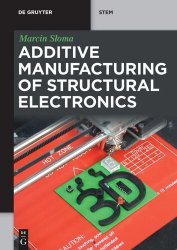Additive Manufacturing of Structural Electronics
- Добавил: literator
- Дата: 9-05-2024, 15:23
- Комментариев: 0
 Название: Additive Manufacturing of Structural Electronics
Название: Additive Manufacturing of Structural ElectronicsАвтор: Marcin Słoma
Издательство: De Gruyter
Год: 2024
Страниц: 154
Язык: английский
Формат: pdf (true), epub (true)
Размер: 10.7 MB
Additive manufacturing, also called rapid prototyping or 3D printing is a disruptive manufacturing technique with a significant impact in electronics. With 3D printing, bulk objects with circuitry are embedded in the volume of an element or conformally coated on the surface of existing parts, allowing design and manufacturing of smaller and lighter products with fast customisation. The book covers both materials selection and techniques. The scope also covers the research areas of additive manufacturing of passive and active components, sensors, energy storage, bioelectronics and more.
The book presents the most important developments to date in the field of additive manufacturing of electronics in its broadest sense, using various functional materials and techniques. The elements presented here are organized in a workflow starting with a description of the additive manufacturing approach, an interesting and quickly developing printed electronic technology, an alternative approach to fabrication of structural electronic circuits, adaptation and application of various materials for additive manufacturing of electronics and ending with challenges and the perspective being in front of presented here domain. Of course, the main and largest part of the book deals with examples of additive approaches to the fabrication of structural electronic components and circuits, covering the scope of conductive materials and basic passive elements, active components with semiconductor materials, photonic components and systems, energy storage devices, a vast area of sensors and micro-electromechanical systems. All this fulfills the book’s main goal of presenting potential solutions and possible practical applications of additively fabricated structures for electronics.
The primary objective of this book is to analyze the development of additive manufacturing, electronics technology and printed electronics, which are synergized in a new direction for research and development called 3D printed structural electronics. All these areas have a significant impact on the development of modern technology and industry. Therefore, it is important to introduce the reader to all of these topics before presenting the ultimate goal of additive manufacturing of electronics in detail. The need to address the topic of additive structural electronics emerges from the huge and growing interest observed in the wave of reports on practical or potential applications of 3D printing, nanomaterials or printed electronics. While this is, in fact, related to the high possibility of utilizing remarkable electronic, mechanical, thermal or optical properties of new materials, most of this information is related to studies published at the initial stages, later distributed by media, suggesting almost unlimited application possibilities, sparking the imagination of applications that could revolutionize our world of technology or science. Readers need to be aware that we will encounter a lot of problems when trying to exploit these unique properties presented in scientific studies to be routinely applied in large-scale applications in the industry. After all, with the development of civilization, we have learned to introduce new techniques for synthesizing materials, selecting their properties, building structured and predictable macrostructures, and we have learned to scale up processes for massive industrial solutions. The same will be true with the additive structural electronics, but it will take some more time than presented in the media. In addition to existing research directions and applications, the book’s last section presents recent research results in the field related to additive manufacturing, stimulating potential applications of 3D-printed structural electronics in emerging technologies. By doing so, I wanted to present developments for future electronic applications and other industry implementation branches, as well as articulate research and technological areas where we can look for new discoveries and breakthroughs.
The book should be understandable both by graduate students with knowledge of mathematics, physics, chemistry and materials engineering, but it should also be useful to researchers from other research areas than those related to mechanics, electronics or materials engineering, who are looking for interdisciplinary inspirations to the development of new research directions in their fields. This goal will be achieved if, after reading the book, the reader changes their perception of additive manufacturing and looks at it as a field that concerns all research aspects of the modern world. While the topic described here is a new paradigm shift, still in the initial development stage, this book is to shed some light on that area of interest and present the origins, available tools and directions to explore. All this is an element of current state-of-the-art achievements described in scientific literature and emerging solutions or profiles of the companies entering the market, with all related challenges and perspectives. Readers familiar with electronic technology will see the new directions for the development, and those familiar with the printed electronics approach will see the broader picture of additive manufacturing and possible new ways for advancement, while experts in additive manufacturing will have a chance to explore new possible directions of their matured techniques. This goal is not necessarily achieved in the course of reading the book “from cover to cover.” The individual chapters have been prepared in such a way that they can be read selectively and used as a reference for further studies on the subject. In this aspect, it can also be used by teaching staff as a textbook for classes on new electronic technologies or as an example of the application of materials engineering for additive manufacturing. This study is based on my experience gained during the last decade of research in the field of additive manufacturing, nanomaterials and printed electronics.
Contents:
Скачать Additive Manufacturing of Structural Electronics
[related-news] [/related-news]
Внимание
Уважаемый посетитель, Вы зашли на сайт как незарегистрированный пользователь.
Мы рекомендуем Вам зарегистрироваться либо войти на сайт под своим именем.
Уважаемый посетитель, Вы зашли на сайт как незарегистрированный пользователь.
Мы рекомендуем Вам зарегистрироваться либо войти на сайт под своим именем.

